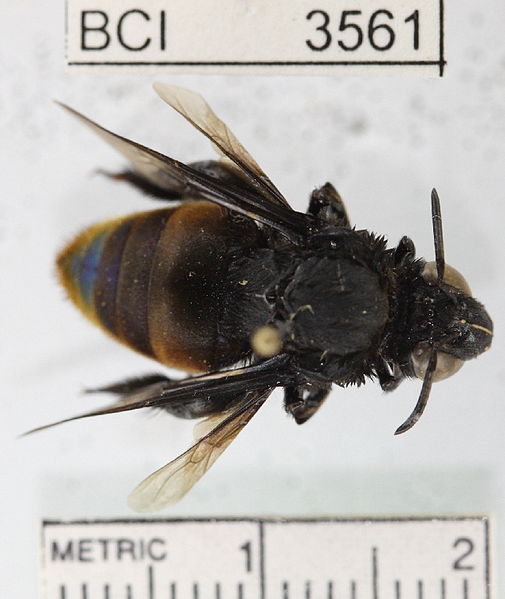Interactions
There are many interactions that take place between B.
excelsa and other organisms. Almost all of these
relationships are mutualistic, so both organisms benefit from
each other in some way. One of the most important of these relationships is the mutualism that takes place between B.
excelsa and orchid bees (specifically, the female bees).
These bees are native to the Amazon area and can be found under
a variety of different taxonomic genera such as Bombus, Centris,
Epicharis, Eulaema, and Xylocopa. Unlike most bees found
in the Unites States, orchid bees are very difficult to maintain
out of the wild, so the utilizing them to fertilize on plantations is extremely
difficult. These bees are the only pollinators that are
usable to the B. excelsa flowers because they are the perfect
size and are strong enough to pry open the petals to get into the complex flower.
Fertilization could not take place without these bees, which
would likely lead to the extinction of B. excelsa (unless
another viable pollinator were utilized).
relationships is the mutualism that takes place between B.
excelsa and orchid bees (specifically, the female bees).
These bees are native to the Amazon area and can be found under
a variety of different taxonomic genera such as Bombus, Centris,
Epicharis, Eulaema, and Xylocopa. Unlike most bees found
in the Unites States, orchid bees are very difficult to maintain
out of the wild, so the utilizing them to fertilize on plantations is extremely
difficult. These bees are the only pollinators that are
usable to the B. excelsa flowers because they are the perfect
size and are strong enough to pry open the petals to get into the complex flower.
Fertilization could not take place without these bees, which
would likely lead to the extinction of B. excelsa (unless
another viable pollinator were utilized).
Fertilization isn’t the only stage of B. excelsa’s life cycle
that requires the use of
 other organisms. Seed dispersal
cannot be done effectively without the help of an animal with jaws
strong enough to gnaw through the shell. Typically, this
animal is an agouti. The agouti eats many of the seeds that it
takes from the fruiting pod, but buries some of them to be eaten
later. At first glance, this doesn’t seem like a mutualistic
relationship, but without the agouti, seed dispersal would be much
less effective for B. excelsa.
other organisms. Seed dispersal
cannot be done effectively without the help of an animal with jaws
strong enough to gnaw through the shell. Typically, this
animal is an agouti. The agouti eats many of the seeds that it
takes from the fruiting pod, but buries some of them to be eaten
later. At first glance, this doesn’t seem like a mutualistic
relationship, but without the agouti, seed dispersal would be much
less effective for B. excelsa.
B. excelsa is a primary producer, and creates a regularly occurring food source that can be utilized in many different ways. Humans have utilized B. excelsa to its highest possible potential by not only using the nuts for food, but as an economical product. Many countries in South America cultivate and export these nuts all over the world. The United States alone consumes about $17 million in nuts annually. These nuts are not a sufficient source of food on their own, but if combined with a healthy diet they can lead to many health benefits (see the Nutrition page!).
To learn more, continue to the Facts page!